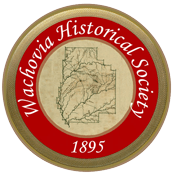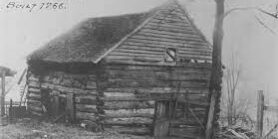This article by Richard Starbuck (1947-2020), former Archivist of the Moravian Church, Southern Province, was published on February 13, 2015, in the Winston-Salem Journal. For many years, Mr. Starbuck was editor of The Wachovia Tract as well as the Treasurer for WHS.
This Saturday, Feb. 14, commemorates a special occasion in the history and heritage of Winston-Salem, for it was on that day in 1765 — 250 years ago — that the site for what would become the Twin City was chosen. The task involved lengthy thoughtful planning, much tramping through the forests that covered the region and a tug-of-war with God Himself.
The site for Winston-Salem entered recorded history in 1753 when the Moravian Church purchased almost 100,000 acres of land in North Carolina from John Carteret, the Earl of Granville, the last remaining Lord Proprietor of the Carolina colonies.
The Moravians named their new land purchase Wachovia. Today Wachovia would be the south central two-thirds of Forsyth County, taking in almost the entirety of Winston-Salem.
The first colony of Moravians arrived in Wachovia from Pennsylvania on Nov. 17, 1753, and began Bethabara, but that settlement was meant only to live up to its meaning: “House of Passage.” For even before they purchased Wachovia, church leaders in Europe envisioned a large city as their administrative headquarters, and that city would be as near the center of their 100,000 acres as the Lord would allow.
For more than a decade the question hung fire as Christian Gottlieb Reuter, the church’s surveyor and prolific mapmaker, plotted out Wachovia and sent reports back to Europe on the lay of the land, its streams and hills. On one 1759 map Reuter noted: “The outstanding city site” — smack dead center of Wachovia, about where Reynolds High School and Auditorium are on the highland above Peters Creek and Hanes Park. And a little to the southwest on the Bethabara-Salisbury “highway” of the time, near today’s Five Points of First Street, Stratford Road, Country Club Road and Miller Street: “A best city site.”
In such weighty matters as selecting the site for your chief large city — or for marriage — Moravians at that time put their faith in God’s hands by turning to the Lot. Prayerfully they would draw a positive or negative Scripture verse, meaning yes or no, and sometimes a blank was also used, indicating further thought should be given to the matter.
Carefully filed in the Moravian Archives, the church’s records repository going back to its beginning in North Carolina in 1753, is an ancient hand-sewn collection of papers labeled Loos Buchlein — Lot Booklet — covering decisions from 1759 to 1779. That includes the fateful meetings for placing their city, recently translated by C. Daniel Crews, retired archivist of the Moravian Church.
Six meetings took place from Dec. 2, 1764, though Feb. 13, 1765, with the Lord answering no or blank through the Lot. One negative Lot carried an exclamation mark, as if “we have been over that already.” The Brethren too showed their own impatience: “The chief settlement, so far as possible, is supposed to be in the center of the entire Tract, but the prettiest places which we know are very much outside the center.”
The Brethren especially favored the “Anna Berg” of Winston overlooking Hanes Park and Peters Creek Valley to the west, but Episcopalians today can breathe a sigh of relief that the Lord reserved that spot for St. Paul’s Episcopal Church.
Finally the fateful day, Feb. 14, 1765, arrived: “Once again 2 sites were suggested, namely: one near the first on the Anna Berg, southeast from there between 2 stumps. 2) one farther to the southeast and nearer the Wach [Salem Creek]. We added a blank Lot to these, and received the indication that no. 2, the one nearer the Wach, was the site for the city we had been seeking for so long.”
As is often the case, in their joy the Moravians turned to their devotional Daily Text: “Today’s Text was very significant to us: ‘Let thine eye be open toward this house night and day, even toward the place of which thou hast said, My name shall be there’” [1 Kings 8:29]. Then they added a word to Scripture: “eternally.” And they concluded: “May grace reign there, with simplicity and a childlike manner. Amen! Amen! Amen!”
And so with the approval of God Himself, as the Moravians trusted, the site was chosen. The next Jan. 6, 1766, the Moravians would begin building their beloved Salem with the felling of the first tree. And the city that they founded with the help of God would grow and join the neighboring new town to become the Winston-Salem of today on Feb. 14, this 250th anniversary year.
Richard W. Starbuck




